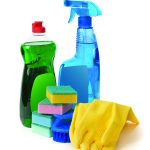Kitchens are awesome places as great food is cooked and eaten there! But they can also be home to dangerous microbes. Did you know that kitchens are more heavily contaminated than bathrooms? Ordinary cleaning practices do little to reduce the microbial load, so kitchen sanitizing is a higher and more frequently needed level of cleanliness. For example, you should clean sponges daily: microwave them for one minute or put them in a dishwasher with a drying cycle.
 Two good reasons for kitchen sanitation
Two good reasons for kitchen sanitation
Reducing germ counts to an acceptable level is the main purpose of kitchen sanitation. In addition, sanitizing procedures help to prevent food spoilage and can prevent micro-organisms interfering with various cooking processes.
Best practices for a healthy kitchen
- Proper personal hygiene, including frequent hand and arm washing and covering cuts
- Proper cleaning and sanitizing of all food contact surfaces
- Proper cleaning and sanitizing of utensils and equipment
- Store food at safe temperatures and throw it out at the proper time
The proper cleaning method is to wash with detergent and hot water, rinse with clear hot water, and then use a sanitizer approved for use on food contact surfaces.
————————
CLEAN PLUS SYSTEMS II
808-678-8021 | www.rosegalera.com

